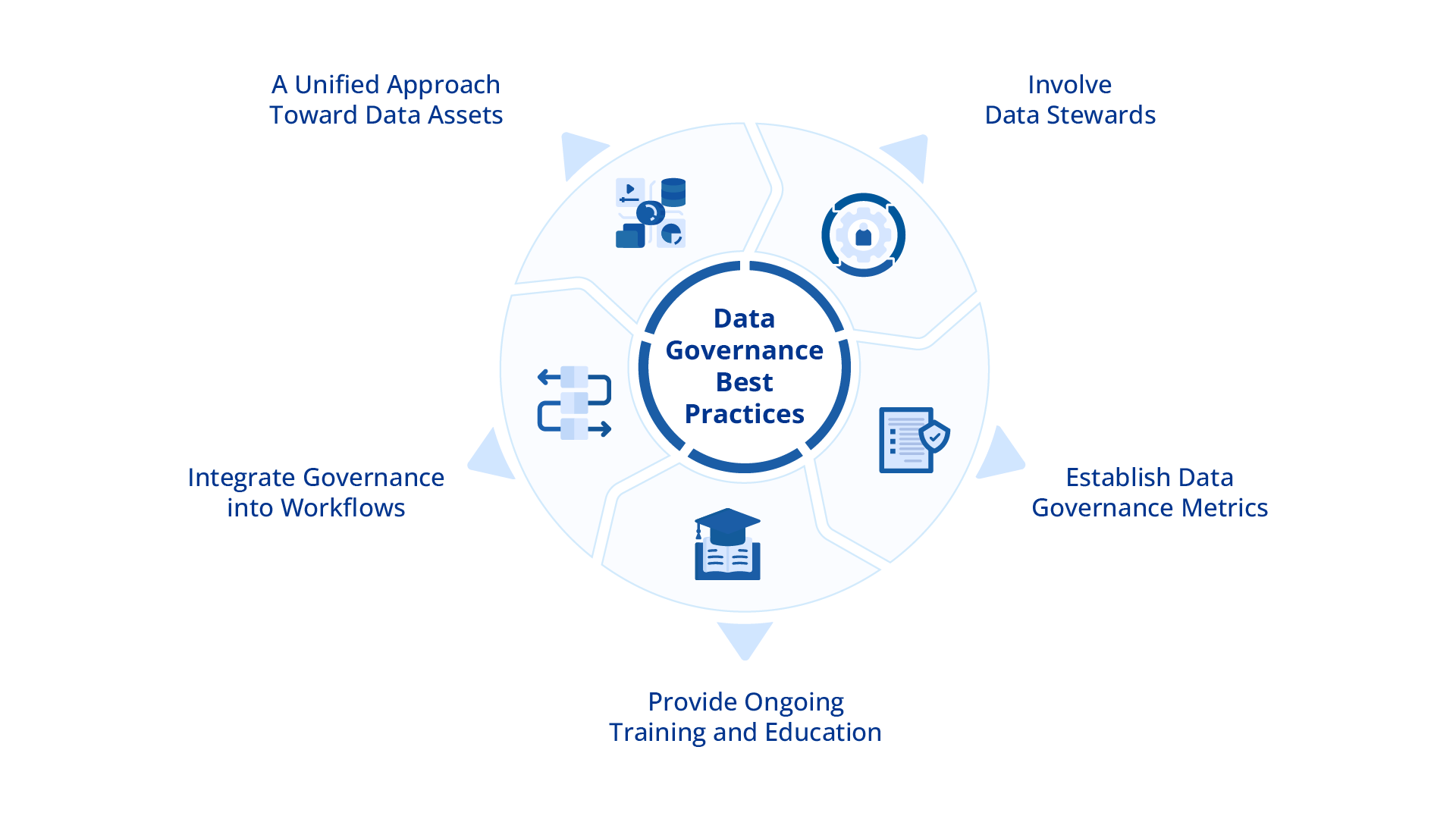
What Is Data Governance and Why It Matters? A Complete Guide
What is Data Governance?
Data governance refers to the strategic management of data within an organization. It involves developing and enforcing policies, procedures, and standards to ensure data is consistently available, accurate, secure, and compliant throughout its lifecycle.
At its core, data governance aims to answer questions such as:
- Who owns the data? Determining clear ownership ensures accountability and responsibility for data quality and compliance.
- What data is being collected and stored? Identifying the collected data types helps understand their significance and potential impact on the organization.
- How is the data used and accessed? Establishing guidelines for accessing and using data ensures it is utilized appropriately and ethically.
- Is the data accurate and reliable? Implementing measures to maintain data integrity ensures that the data is accurate, consistent, and trustworthy.
- Is the data secure? Implementing security measures to protect data from unauthorized access, breaches, or misuse is crucial for maintaining confidentiality and compliance with regulations.
Learn about the dfferences between three core data governance concepts: a data catalog, data dictionary, and business glossary.
Data Governance Vs. Data Management
What’s the difference between data governance and data management?
Data governance primarily focuses on establishing the framework, policies, and processes for ensuring data quality, integrity, security, and compliance across the organization. On the other hand, data management is the broader set of practices and activities involved in the day-to-day handling, storage, retrieval, and maintenance of data assets.
While data governance sets the rules and guidelines for managing data, data management involves implementing those rules through various operational tasks such as data collection, storage, integration, cleansing, and analysis.
Related: Find out how data governance helps establish effective data management.
| Aspect | Data Governance | Data Management |
| Focus | Establishing policies, standards, and processes for ensuring data quality, integrity, security, and compliance | Implementing operational tasks and activities involved in handling, storing, retrieving, and maintaining data |
| Purpose | Ensuring accountability, compliance, and responsible management of data assets across the organization | Efficiently handling data throughout its lifecycle to derive value and support business operations. |
| Implementation | Establishes the rules and guidelines for data management activities and provides oversight and enforcement | Executes the rules and guidelines established by data governance to manage data effectively |
| Stakeholders | Business stakeholders, IT professionals, data stewards, compliance teams | Data analysts, database administrators, IT professionals, data stewards, and end-users |
| Outcome | Ensures data quality, integrity, security, and compliance across the organization | Ensures efficient data handling supports decision-making and business operations. |
The Importance of Data Governance
Data governance facilitates accessibility by establishing clear guidelines for who can access the data under what circumstances. These guidelines ensure that every employee has access to data required for their roles, promoting collaboration and informed decision-making across the organization.
- Ensure compliance: Reliable data fuels informed choices at all levels. Trust in the information you’re using empowers you to make strategic decisions confidently.
- Mitigate risks: Data governance safeguards sensitive information, reducing the risk of data breaches and protecting your organization’s reputation while building trust with stakeholders and customers.
- Improve data quality: Effective data governance processes establish standards and protocols for data collection, storage, and management, leading to accurate, consistent, and up-to-date data.
Related: Find out how data governance relates to effective data quality.
Key Stakeholders in Data Governance
Data governance involves collaboration between executive leadership, IT professionals, data stewards, compliance teams, and data analysts. Adapting to evolving business needs and regulatory requirements requires continuous monitoring, assessment, and improvement.

The key stakeholders in data governance include:
- Executive leadership: Provide direction and support to drive the strategic implementation of data governance.
- IT professionals: Implement and maintain technical infrastructure to support data governance initiatives.
- Data stewards: Ensure data quality, integrity, and compliance within specific areas or datasets.
- Compliance teams: Oversee adherence to regulations and standards governing data usage and privacy.
- Data analysts: Utilize governed data to extract insights and inform decision-making processes.
Modern companies are increasingly opting for unified, no-code solutions. They provide a user-friendly platform for all stakeholders to collaborate seamlessly, regardless of technical expertise. It empowers the leadership team to define governance policies, while IT professionals, or even data stewards, can implement them efficiently due to the no-code environment.
Data stewards and compliance teams can easily monitor and enforce governance standards, while data analysts can seamlessly access data for reporting and analytics, fostering effective collaboration across the organization.
Related: Learn about active data governance and automated data governance.
How Does a Data Governance Program Work?
A Data Governance Program operates by establishing a framework that includes various processes, policies, and practices aimed at ensuring the effective management of an organization’s data assets, including:
- Policy Development: The program begins with developing comprehensive data governance policies that outline rules and guidelines for data management, usage, security, and compliance. These policies are typically designed in collaboration with key stakeholders across different departments and are aligned with the organization’s strategic objectives.
- Data Ownership and Accountability: Clear ownership and accountability for data assets are defined within the program. This step involves identifying data stewards or custodians responsible for specific datasets or domains. Data stewards uphold data quality standards, control data access, and ensure compliance.
- Data Standards and Metadata Management: Standardizing data formats, definitions, and naming conventions is crucial for ensuring consistency and interoperability across the organization. The program establishes processes for metadata management, including the documentation of data lineage, definitions, and usage policies.
- Data Quality Management: The program implements processes and tools for monitoring and improving data quality. This step involves identifying data quality issues, assessing their impact on business operations, and implementing corrective measures to address them. Continuous data profiling, cleansing, and validation are critical components of data quality management.
- Data Security and Compliance: Data governance ensures that appropriate security measures are in place to protect sensitive data from unauthorized access, breaches, or misuse. Compliance with relevant regulations and standards, such as GDPR, HIPAA, or PCI-DSS, is critical to data governance. The program establishes controls and processes to ensure compliance with data protection laws and industry regulations.
- Data Lifecycle Management: Effective data governance involves managing the entire data lifecycle from creation to archival or disposal. This step includes defining policies for data retention, archiving, and disposal based on business requirements, regulatory obligations, and data value.
- Monitoring and Enforcement: The program includes mechanisms for monitoring adherence to data governance policies and enforcing compliance. This stage may involve regular audits, data quality assessments, and access controls to ensure teams follow data governance policies effectively.
A data governance program establishes a structured approach to managing data assets, ensuring their quality, integrity, security, and compliance throughout their lifecycle. A unified environment and no-code solutions offer advantages by providing a centralized platform for collaboration and enabling stakeholders of varying technical backgrounds to contribute to governance initiatives efficiently.
What is a Data Governance Framework?
A data governance framework is a detailed plan guiding your company’s implementation of data governance. Think of it as a set of rules and processes that help you manage your data smartly and organized. Following this framework lets you maintain consistency and efficiency in handling your company’s data.
- Data Management Body of Knowledge (DMBOK): Developed by the Data Management Association (DAMA), DMBOK provides a comprehensive guide to best practices, principles, and processes in data management, including data governance.
- The Data Governance Institute (DGI) Framework: DGI offers a framework that outlines the components, principles, and practices of data governance, including organizational structures, policies, and processes.
- Control Objectives for Information and Related Technology (COBIT): COBIT, developed by ISACA, provides a governance and management framework for IT processes, including data governance, focusing on control objectives and maturity models.
- Open Group Architecture Framework (TOGAF): TOGAF offers a framework for enterprise architecture, which includes aspects of data governance within its broader scope of managing organizational assets and capabilities.
The benefits of a data governance framework include:
- Improved collaboration across the organization to manage all data assets in alignment with corporate objectives.
- Greater visibility into data governance efforts, leading to effective coordination and control of the data assets.
- Greater transparency in data management processes, ensuring clarity and accountability.
- Efficient monitoring of data consumption and usage, guided by a structured blueprint.
- A robust foundation for regulatory compliance practices, ensuring compliance with industry standards and regulations.
The Importance of Data Lineage
Data lineage strengthens data governance by providing transparency, control, and accountability over the organization’s data assets. Data lineage systematically tracks data from origin to its various transformations and destinations within an organization’s data architecture. It provides a detailed record of how data moves through different systems, processes, and databases. This information is crucial for ensuring data quality and understanding the impact of changes to data sources or structures.
Implementing a unified solution with data lineage capabilities instead of third-party data lineage tools improves data governance. It provides a centralized platform for managing and visualizing data lineage, making it easier to trace data dependencies and identify potential issues. With this visibility, organizations can make informed decisions about data management strategies and ensure that data is used effectively and responsibly across the organization.
Learn more about data lineage and the differences between data lineage and data provenance.
Data Governance Best Practices

A Unified Approach Toward Data Assets
Establish a data governance framework involving all types of data assets across the organization, including structured databases, unstructured documents, and semi-structured data from various sources like APIs. This ensures a unified approach to managing data, reducing the risk of overlooking critical data assets and enhancing overall governance effectiveness.
Involve Data Stewards
Encourage participation from data analysts, engineers, and business users in governance efforts. Leverage their expertise and insights to inform governance decisions and policies. This approach fosters a sense of ownership and responsibility among practitioners, leading to more tailored and effective governance practices aligned with business needs.
Integrate Governance into Workflows
Integrate governance practices seamlessly into existing workflows and tools used by practitioners. Implement data quality assessments, privacy compliance checks, and access controls directly within your data management solutions to ensure that governance becomes integral to routine operations. This approach minimizes disruptions and encourages widespread adoption of governance practices throughout the organization.
Establish Data Governance Metrics
Define key performance indicators (KPIs) and metrics to measure the effectiveness of your data governance initiatives. This step includes tracking metrics such as data quality scores, compliance levels, and user satisfaction with data accessibility. By regularly monitoring these metrics, you can identify areas for improvement and demonstrate the value of data governance to stakeholders.
Provide Ongoing Training and Education
Offer continuous training and educational programs to enhance employee awareness and understanding of data governance principles and practices. This initiative may include training sessions on data management best practices, compliance requirements, and the use of data governance tools and technologies. Investing in employee development can empower your team to play an active role in upholding data governance standards.
Learn more about data governance best practices.
Investing in Data Governance for Success
Data governance is critical to modern business operations, ensuring that data is managed effectively and responsibly throughout its lifecycle. By establishing clear policies, standards, and processes, you can promote accessibility, security, and quality of data assets, fostering collaboration, informed decision-making, and compliance with regulatory requirements.
With the involvement of key stakeholders and the adoption of best practices, a robust data governance program can play a role in mitigating risks and achieving strategic objectives.
Astera’s Data Governance Solution
Astera’s data governance solution empowers organizations to leverage these benefits and create a single source of truth for their data. With a strong focus on data quality standards and validation processes, Astera guarantees the reliability and accuracy of data.
Its data ownership initiatives ensure that responsible parties are accountable for data, while data enrichment and discovery functionalities enhance the value of the information available. This comprehensive approach supports informed decisions and strengthens their data-centric foundation for success.
Want to learn more about Astera? Sign up for a demo or contact us.
Take Control of Your Data Assets!
With its seamless data sharing and robust access controls, Astera Data Governance ensures the integrity and security of your data assets. Start your free 14-day trial now and elevate your data governance strategy.
Schedule A Demo Astera AI Agent Builder - First Look Coming Soon!
Astera AI Agent Builder - First Look Coming Soon!

